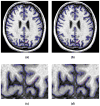Simple paradigm for extra-cerebral tissue removal: algorithm and analysis
- PMID: 21458576
- PMCID: PMC3105165
- DOI: 10.1016/j.neuroimage.2011.03.045
Simple paradigm for extra-cerebral tissue removal: algorithm and analysis
Abstract
Extraction of the brain-i.e. cerebrum, cerebellum, and brain stem-from T1-weighted structural magnetic resonance images is an important initial step in neuroimage analysis. Although automatic algorithms are available, their inconsistent handling of the cortical mantle often requires manual interaction, thereby reducing their effectiveness. This paper presents a fully automated brain extraction algorithm that incorporates elastic registration, tissue segmentation, and morphological techniques which are combined by a watershed principle, while paying special attention to the preservation of the boundary between the gray matter and the cerebrospinal fluid. The approach was evaluated by comparison to a manual rater, and compared to several other leading algorithms on a publically available data set of brain images using the Dice coefficient and containment index as performance metrics. The qualitative and quantitative impact of this initial step on subsequent cortical surface generation is also presented. Our experiments demonstrate that our approach is quantitatively better than six other leading algorithms (with statistical significance on modern T1-weighted MR data). We also validated the robustness of the algorithm on a very large data set of over one thousand subjects, and showed that it can replace an experienced manual rater as preprocessing for a cortical surface extraction algorithm with statistically insignificant differences in cortical surface position.
Copyright © 2011 Elsevier Inc. All rights reserved.
Figures



 ABA. C shows the hard tissue segmentation. D is the morphological operations phase of the algorithm. Image 4, in D, must pass a sanity check before it is approved as the mask.
ABA. C shows the hard tissue segmentation. D is the morphological operations phase of the algorithm. Image 4, in D, must pass a sanity check before it is approved as the mask.
 1, (e) mask after erosion and retaining largest connected component, (f) mask after hill descent but prior to the topologically constrained morphological closing.
1, (e) mask after erosion and retaining largest connected component, (f) mask after hill descent but prior to the topologically constrained morphological closing.
 H1) human rater, (c) (
H1) human rater, (c) (
 H2) an alternative human rater and (d) (
H2) an alternative human rater and (d) (
 S) output from SPECTRE.
S) output from SPECTRE.
 G), and (c) the result from SPECTRE (
G), and (c) the result from SPECTRE (
 S). The corresponding Containment Index score for this subject is 0.99779, see the text for an explanation of these numbers.
S). The corresponding Containment Index score for this subject is 0.99779, see the text for an explanation of these numbers.





References
-
- Acosta-Cabronero J, Williams GB, Pereira JMS, Pengas G, Nestor PJ. The imapct of skull-stripping and radio-frequency bias correction on grey-matter segmentation for voxel based morphometry. NeuroImage. 2008;39 (4):1654–1665. - PubMed
-
- Ashburner J, Friston KJ. Voxel-based morphometry: the methods. NeuroImage. 2000;11 (6):805–821. - PubMed
-
- Bazin PL, Pham DL. Topology-Preserving Tissue Classification of Magnetic Resonance Brain Images. IEEE Trans Med Imag. 2007;26 (4):487–496. - PubMed
-
- Boesen K, Rehm K, Schaper K, Stoltzner S, Woods R, Luders E, Rottenberg D. Quantitative comparison of four brain extraction algorithms. NeuroImage. 2004;22 (3):1255–1261. - PubMed
Publication types
MeSH terms
Grants and funding
LinkOut - more resources
Full Text Sources

